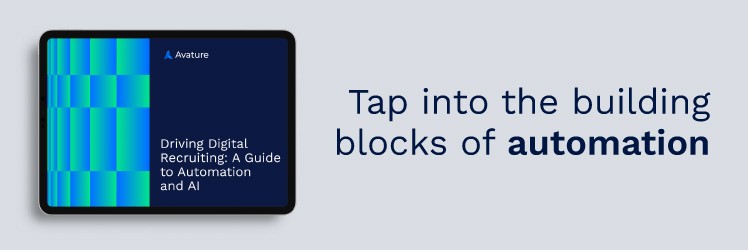In today’s fast-paced business world, staying ahead requires focusing on genuine innovation and development instead of chasing trends. In this sense, Artificial intelligence (AI) is a powerful tool that can revolutionize how organizations manage talent and streamline hiring practices. However, the conversation around AI in HR is often driven by hype. Organizations must invest in the right technology, train their teams and foster continuous development to benefit from AI and truly leverage its potential.
AI’s evolution in HR will likely involve incremental improvements rather than radical changes. These adjustments, while small, will represent significant advancements over time. Read on and learn from our CEO, Dimitri Boylan, about adopting a progressive and strategic approach for sustainable change in recruiting practices.
How AI and Social Media will Revolutionize Recruiting
Enhancing Recruitment with AI
AI is reshaping how organizations connect with talent, revolutionizing the hiring process by helping them find the perfect candidates faster and more accurately. Avature offers a wide range of possibilities in this sense, from using semantic matching to match candidates with the right roles to AI chatbots that guide applicants through the hiring journey with personalized assistance.
These tools simplify tasks and enable recruiting teams to focus on building a diverse and talented workforce. As businesses compete globally, integrating AI into recruitment saves time and resources and enhances the ability to attract and retain top-notch talent.
Understanding the functionalities AI offers recruiting teams is essential, as many are already proving effective in the marketplace. Below, we cover the most important aspects to consider about Avature AI.
Leveraging Semantic Search for HR Success
Instead of relying on keyword-based searches, AI-powered semantic search can understand the recruiter’s intent when searching for qualified candidates and provide related recommendations. This helps them discover candidates they might not have initially considered. Semantic search also enhances career sites by helping candidates find relevant roles, thus improving hiring efficiency and candidate experience.
Streamlining Talent Matching with AI
AI can recommend candidates for new roles and even rank them with compatibility percentages. This saves recruiters time and resources by avoiding starting searches from scratch. Avature’s explainability feature allows them to hover over the score to see how it was formulated. Also, the weighting of factors that are contemplated for the score can be adjusted depending on role, region and other variables. In this sense, the score is an indicator that helps recruiters decide if a candidate is relevant or not, but they always remain in control.
Additionally, in a context where employee retention is challenging, semantic matching can identify internal opportunities for employees based on their experience, interests and skills, promoting development and internal mobility while boosting organizational agility.
AI Chatbots: Revolutionizing Candidate Interaction
AI-powered chatbots can help enhance the candidate journey from first contact by providing quick, accurate answers to frequently asked questions and personalized job recommendations. In this way, next-generation chatbots can improve the job search experience, helping organizations to drive increased conversion.
Predictive Analytics for HR Success
AI offers advanced predictive analytics capabilities for HR teams, enabling organizations to identify patterns and trends in talent data. This includes forecasting employee turnover and even identifying future skill requirements. This information allows organizations to make strategic, data-driven decisions that align their workforce with long-term business goals. It also helps talent acquisition teams position themselves as business advisors, dramatically transforming the function from operational back office to strategic partners.
Building a Robust Skills Framework with AI
AI can extract and analyze skills from job descriptions and candidate profiles, creating more accurate profiles and suggesting related skills. It also considers the level of proficiency for each skill, improving profile matching.
Crafting Effective Job Postings with Generative AI
Generative AI can streamline job description writing, making it more accurate and objective. This technology can also power knowledge management systems, providing accurate and timely responses to employees seeking relevant information and liberating HR teams from having to respond to these kinds of queries.
Future-Ready HR: Strategically Integrating AI for Lasting Impact
The powerful functionalities outlined above demonstrate that AI is one of the most transformative forces of our time and that its impact on recruiting and HR more broadly is only just beginning. Implementing AI progressively and strategically ensures it supports and enhances the output of talent acquisition and management teams, improving efficiency without replacing humans.
To maximize AI’s potential, HR teams must understand how it works and its criteria for generating results to ensure that it is being used ethically and compliantly. The nature of HR work is sensitive, so choosing transparent AI means these teams can retain control, adjusting parameters to meet specific needs. This facilitates conscious adoption and positions AI as a catalyst for positive, sustainable change.
This article was originally published in Spanish by Dirigentes Digital.



